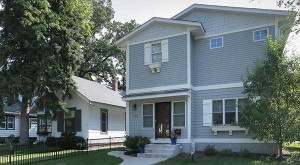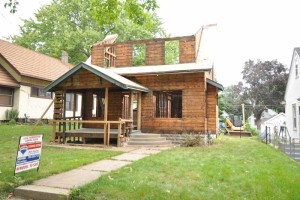Small Home Gazette, Fall 2014
Taming Monster Homes
Minneapolis refines an ordinance requiring new homes to play nicer with neighbors
There are four phases in the lifecycle of housing stock in a city: growth, maturity, decline and revitalization. Those of us who have lived in the Twin Cities for several decades have a clear picture of what maturity and decline look like. They’re ugly. Ongoing revitalization is ideal in theory, but it’s not without complications and compromises.
I’m not sure what building restrictions were in effect when our bungalow neighborhoods were built, but through my work and service to the City of Minneapolis, I’m familiar with the more recent history of our residential building code.
In the years prior to 2007, the City of Minneapolis had few restrictions on the size of a new home. There were front and side setback limitations, that is, the distance from the house to the property line. Lots that were 40 feet wide had setbacks of 5 feet on both sides; wider lots had 6 feet.
Home height was limited to 35 feet measured from the ground to the peak of the roof. There was no limitation placed on basement height. If you wanted, you could build a basement projecting 6 feet out of the ground and compensate on top with a shallow-pitched roof to achieve the overall 35-foot height. There was also no limitation in building to the rear of the lot, so some new homes were built right to the alley with a garage at ground level and a bedroom on top of it.
In the late 1990s in desirable neighborhoods, speculators began buying small houses, tearing them down, and building 3,000- to 4,000-square-foot homes that loomed close to lot boundaries and towered above neighboring houses, casting them into shadow. The owners of older, smaller homes became increasingly frustrated as enormous houses proliferated, changing the character of the neighborhoods. There was a visceral reaction against them, and residents increasingly voiced complaints to city officials.
First Attempt
In 2007, a new ordinance created limitations on the size of new homes built on city lots. The ordinance is much more detailed than described here, but these are the main points that limited home size.
A “floor area ratio” was created. If your lot has 5,000 square feet, you may build a home with living space that amounts to 50 percent of that lot size, or 2,500 square feet. This applied to all levels that project more than 4 feet above ground. Ground level was defined as the level in place prior to the demolition of the original home.
If the new house had an attached garage, up to 250 square feet of the garage was not counted as part of the floor area ratio. Height was limited to 30 feet measured at the mid-point between the upper story and the peak of the roof. The city, however, was not very good at enforcing this last piece. Some builders brought in dirt to raise the lot elevation to enhance views, which pushed the whole house up even higher.
It’s worth noting that 2007 was the beginning of the recession, which meant that fewer new houses were built in the years immediately following the ordinance. As the economic recovery progressed, new home construction picked up, more teardowns began, and the limitations of this ordinance became apparent.
New Limitations
As anyone who follows local news knows, the new limitations didn’t quell the outcry. Large, lot-filling houses continued to replace small older homes, and critics began pressing for further size reductions.
An amendment to the 2007 ordinance was passed by the City of Minneapolis this summer and applies to new building permits issued on or after October 1, 2014. Under the amendment, the floor area ratio has not changed, but height has been reduced. And basement projection out of the ground has been reduced from 4 feet to 2½ feet. Maximum height at the mid-point of the roof has been reduced from 30 feet to 28 feet, and maximum height at the peak of the roof is now 33 feet. Attached garages now have all of their square footage counted in the floor area ratio.
There’s more to the amendment—the entire ordinance can be found on the city’s website. But the net effect is that these homes have been pulled closer to the ground.
|
|
Minneapolis |
Minneapolis |
Minneapolis |
|
Roof height |
35′ at peak |
30′ at midpoint, 35’ at peak |
28′ at midpoint, 33′ at peak |
|
Floor area ratio |
None |
50% of lot size |
50% of lot size |
|
Basement height above ground |
No restrictions |
Can be 4′ or less above ground |
Can be 2.5′ or less above ground |
|
Attached garage exclusion |
No restrictions |
Yes; first 250 sq. ft. excluded |
No exclusion |
|
Front setback |
Nominally 25 feet, but must match existing setbacks on block |
Nominally 25 feet, but must match existing setbacks on block |
Nominally 25 feet, but must match existing setbacks on block |
|
Side setbacks |
5′ for lot width up to 40′; 6′ for wider lots |
5′ for lot width up to 40′; 6′ for wider lots |
5′ for lot width up to 40′; 6′ for wider lots. May vary for larger lots |
|
Back setback |
None |
None |
None |
This table illustrates the evolution of new house size limits in Minneapolis.
Final Thoughts
We will continue to see teardowns, and we will see what effect these changes make. I suspect that in a few years we will see more changes proposed. We’ve decided that stricter management of the revitalization of our neighborhood housing is necessary, and we know that better enforcement is critical. But in my view, having to manage the revitalization of a city’s housing stock is far preferable to earlier phases in a neighborhood’s lifecycle. Our neighborhoods are desirable again!
John Finlayson is a member of the Twin Cities Bungalow Club Board of Directors, a professional housing appraiser, and a member of the City of Minneapolis’ Zoning Board of Adjustment.
Further Reading:
“St. Paul Could Be Next for Teardown Rules”
http://tinyurl.com/m96c2mh
“The Neighborhood Lifecycles: The Only Constant is Change”
http://tinyurl.com/k7r2zlr
Minneapolis new home construction ordinance
http://tinyurl.com/ka96lss













